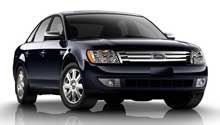There’s a new Taurus at your local Ford store. You may have noticed, however, that it’s pretty much the same as the car Formerly Known as Five Hundred. Depending on whom you believe, the new Taurus has been improved in 300 or 500 ways from the old Five Hundred, itself based on the architecture of the Volvo S80, but the most noticeable difference is a new grille derived from the 1948 F1 pickup.
Apparently Alan Mulally, Ford’s new boss, is down on alliteration (Ford Focus, Fusion, Five Hundred…), but thinks heritage names like Taurus and heritage hallmarks like the grille will improve the company’s fortunes. Indeed, Taurus was a trendsetter when introduced for 1986. With smooth styling that made competitors Chevrolet Celebrity and Plymouth Caravelle look dowdy, it sold well from the start, by 1987 outselling the comparable Celeb models (Caravelle was off the low end of the chart). A sibling Mercury Sable presented a slightly more exotic outlook with full-width light bar in front and a modest hemline at rear. Station wagons accompanied both cars’ sedan models.
For 1992, both Taurus and Sable were given a new, slightly crisper, skin. This second generation Taurus, built through 1996, was the best-selling single model in the US auto industry. An SHO performance version, with Yamaha-tuned 220-bhp V6, was introduced for 1989, available only with 5-speed transmission, which limited sales. The second-gen SHO finally made an automatic optional in 1993, and sales doubled.
Hoping to recreate the buzz that accompanied the first Taurus, Ford pushed the enveloped with the third generation, rolled out for 1996. Unfortunately, the car displayed an obsession with ovals, both front and rear, and in the wagon nearly absurd. Apparently evoking the oval corporate logo, this icon pervaded the entire line, showing up in unlikely places like Escort dashboards. Thankfully the Sable eschewed the oval backlight, and sales did hold at 1995 levels, but the hoped-for surge never arrived. A fourth-gen for 2000 brought a nose- and tail-job to both Taurus and Sable. The magic, however, was gone, and Asian manufacturers had long since run away with the market segment. Whereas in 1986 only the Honda Accord directly competed with Taurus, today every Japanese and Korean manufacturer has a contender and the rather bland Toyota Camry is the best selling passenger car in the United States.
Some blame the Five Hundred’s tall stance for disappointing sales, though its owners, and those of the matching Mercury Montego, praise the driver visibility it provides. Henry J. Kaiser is said to have quipped that his star-crossed cars would have sold like hotcakes if they’d had a Buick badge. Whether retreading old names (the Montego has been redesignated “Sable“) can resuscitate Ford’s fortunes remains to be seen. So far it’s not encouraging: September sales of the new Taurus were 30 percent behind those of last year’s Five Hundred. If names controlled sales, wouldn’t Oldsmobile still be alive and well and selling Cutlass Supremes?

